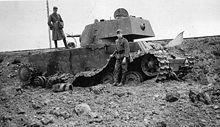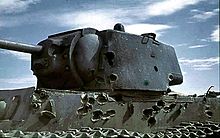KW-1
| KW-1 | |
|---|---|

KW 1 model 1941 |
|
| General properties | |
| crew | 5 |
| length | 6.80 m |
| width | 3.35 m |
| height | 2.70 m |
| Dimensions | 43.5 tons |
| Armor and armament | |
| Armor | 35-90 mm |
| Main armament | 1 × 76.2 mm L / 41 F-32 cannon |
| Secondary armament | 3 × 7.62mm DT machine gun |
| agility | |
| drive | V12 diesel engine W-2 K 550 PS |
| suspension | Torsion bars |
| Top speed | 35 km / h |
| Power / weight | 12.6 hp / t |
| Range | 335 km (road) |
The KW-1 ( Russian КВ-1 ) was a Soviet tank of the KW series , named after the commander and politician Marshal Kliment Yefremovich Voroshilov .
According to Soviet terminology, the KW was considered a heavy tank. At the beginning it had a previously unknown strong armor, which was further strengthened in the course of the war, as well as a 76.2 mm cannon. The top speed of 20 km / h in the field was relatively low and the power transmission (clutch / gearbox) was unreliable, so that these tanks were more often broken down than they were destroyed by enemy action. This type was called Dicker Bello by the German troops , in reference to its heavy armor. In the course of the war, all KWs fell behind against the more modern German Tiger and Panther tanks . Attempts to further develop the KW led to a new series of heavy Soviet tanks that began with the IS-1 and which replaced the KW in late 1943.
development
Development of the KW-1 began on February 1, 1938, before the official approval, which was only granted on February 27. The KW-1 was a parallel development to the SMK . The latter did not get beyond the prototype stage, especially since the head of the development team favored a tank with only one turret. The development of the KW progressed quickly, as elements of the SMK were taken over. The first copy was completed on September 1, 1938, at the same time as the prototype of the SMK. The first copies of the KW-1 were equipped with the 76.2 mm L-11 (L / 30.5) cannon of the SMK, the series models received the 76.2 mm F- cannon derived from the SiS-3 32 and from 1941 the SiS-5 .
history

Even before the end of the test phase, the KW-1 was used in the winter war against Finland in 1940. The tests were continued at a later point in time, revealing serious technical defects. Production was already underway and so the test results were ignored.
At the beginning of the German-Soviet War , the KW-1 was the most powerful tank in the Red Army , as the T-34 was only in small numbers in the units. Despite the often very inexperienced crews, the KW-1 was a very serious opponent for the German tanks. During the early stages of the war, the KW-1 played an important role as it was difficult to destroy by German tanks. The 88mm anti-aircraft gun of the Wehrmacht , however, could destroy the normal combat range of the tank. Most of the KW-1 were not destroyed in combat, but failed due to technical defects. The KW-1 was adapted several times to the changed circumstances. With the KW-1e, a better armored variant was produced, but it was very slow due to the increased weight. The KW-1s, on the other hand, was a lighter armored and therefore faster variant of the KW-1, which, however, no longer offered adequate protection against the guns of the Wehrmacht, which had already been improved at that time, and because of its own weak cannon compared to the much faster and above all cheaper T. -34 had no additional use. The final variant was the transition model KW-85 (1943), of which around 130 were built. This tank combined the turret developed for the IS series with the 85 mm cannon with the hull of the KW-1.
The attempt to further develop the tanks of the KW series from 1942 onwards , after many prototypes (including the KW-13 ), ultimately led to the new and significantly improved Josef Stalin tank in autumn 1943 , the first model of which was the IS-1 with 85 mm Cannon and culminated in the IS-2 with a 122 mm cannon in 1944 . The renaming was due in particular to the fact that Voroshilov had meanwhile fallen politically out of favor with Stalin.
On the chassis of KW-1 is also formed of KV-2 , one armed with a 152 mm artillery tanks for combating bunkers and fortified positions, as well as the self-propelled gun SU-152 .
Use in the Wehrmacht
Captured KW-1 tanks were used by the German Wehrmacht under the designation Panzerkampfwagen (PzKpfw) 753 (r). Operational captured KW-1 were immediately used by German units. These were used as long as ammunition and spare parts were available. In order to prevent the KW-1 now deployed on the German side from being attacked by their own or allied troops, they were marked with oversized crosses on the sides. The KW-1 was not used as planned by the Wehrmacht until mid-1942. Now the KW- 1s were overhauled before they were used by the Panzer Repair Group North in Riga . Among other things, the tanks were repainted and converted. From Riga the distribution to captured armored units of the Wehrmacht took place. In addition, there is evidence of a KW-1 model 1942 with a cast tower, which the Panzer Regiment 204 of the 22nd Panzer Division independently converted to a German 7.5 cm KwW 40 L / 43 and the commander's cupola of a Panzerkampfwagen IV . The vehicle itself was captured near Bjelgorod at the end of 1943.
Because of the heavy weight, there were often problems with the recovery of captured KW-1s that had been abandoned by the Red Army due to technical defects in the engine or gearbox. In the autumn of 1943 the OKH issued the order to use the German KW-1 as a priority recovery vehicle . The KW-1 armored recovery vehicles should be used for the recovery of heavy vehicles of all kinds. The armored turrets should remain on the tank for self-protection and to increase the weight of the traction device. The KW-1, which had been converted for towing purposes, could not be used for other tasks. At least 50 KW-1s used by the Wehrmacht can be found in Wehrmacht files. The number was certainly much higher, since many files were lost or are incomplete. The Finnish Army also used captured KW-1.
Technical specifications

| Panzerkampfwagen KW-IA | |
| 0 General characteristics | |
| crew | five soldiers |
| Combat weight | 43.5 t |
| Ground pressure | 0.70 kg / cm 2 |
| length | 6.80 m |
| width | 3.35 m |
| height | 2.70 m |
| Ground clearance | 52 cm |
| Chain width | 70 cm |
| 0 armament | |
| Main armament | 76.2 mm L / 41 F-32 cannon (from 1941 SiS-5 ) |
| Secondary armament | 3 × MG |
| Combat load HW | 111 floors |
| Combat load MG | 2080 rounds |
| 0 mileage | |
| engine | Twelve-cylinder - diesel engine |
| cooling | water |
| Displacement | 38.88 l |
| Bore / stroke | 150 mm × 180 ( connecting rod : 186.7 mm) |
| maximum speed | 1900 / min. |
| power | 404 kW (550 PS) |
| Liter output | 14.1 hp / l |
| Power / weight | 12.6 hp / t |
| transmission | five forward gears, one reverse gear |
| Speed limit road | 35 km / h |
| Fuel supply | 650 l |
| Range road | 335 km |
| Range terrain | 200 km |
| steering | Steering brakes |
| Rollers | 6th |
| suspension | Torsion bars |
| Fording depth | 145 cm |
| 0 armor | |
| Tub bow | 75 mm |
| Tub side | 75 mm |
| Tub rear | 75 mm |
| Tub roof | 35 mm |
| Tub bottom | 35 mm |
| Tower cover | 90 mm |
| Tower front | 75 mm |
| Tower side | 75 mm |
| Turret stern | 75 mm |
| Tower roof | 35 mm |
See also
literature
- Alexander Lüdeke: captured tanks of the Wehrmacht - Great Britain, Italy, Soviet Union and USA 1939–45. Motorbuch Verlag, Stuttgart 2011, ISBN 978-3-613-03359-7 .
Web links
Individual evidence
- ↑ Lüdeke: captured armor of the Wehrmacht. 2011, pp. 68-71.
- ↑ Thomas L. Jentz : The German Armored Troop 1933-42. Podzun-Pallas Verlag, 1998, ISBN 3-7909-0623-9 , p. 282.



